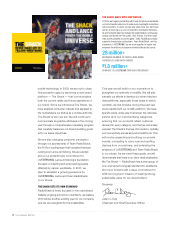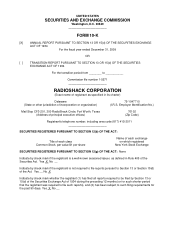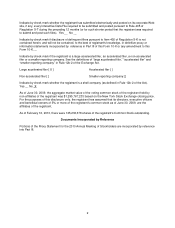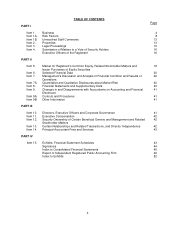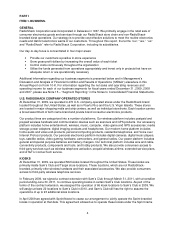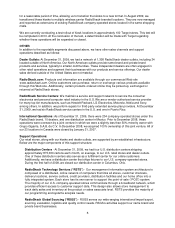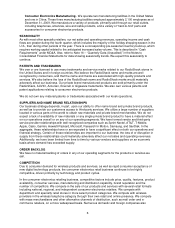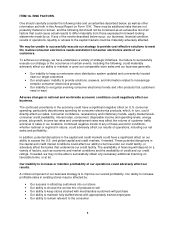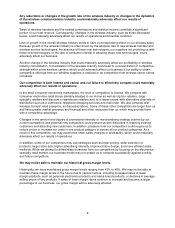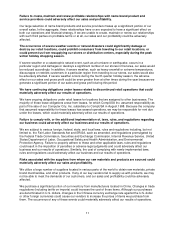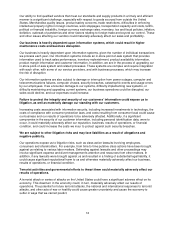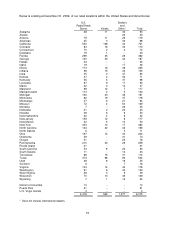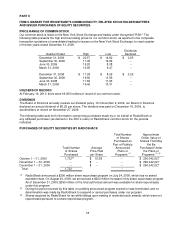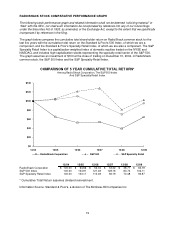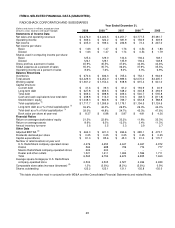Radio Shack 2009 Annual Report Download - page 17
Download and view the complete annual report
Please find page 17 of the 2009 Radio Shack annual report below. You can navigate through the pages in the report by either clicking on the pages listed below, or by using the keyword search tool below to find specific information within the annual report.10
Our inability to effectively manage our receivable levels, particularly with our service providers,
could adversely affect our results of operations.
We maintain significant receivable balances from various service providers, such as Sprint Nextel, AT&T,
and T-Mobile, consisting of commissions, residuals and other funds related to these relationships.
Changes in the financial markets or financial condition of these service providers could cause a delay or
failure in receiving these funds. A significant delay or failure to receive these payments could adversely
affect our financial results or financial condition.
Our inability to effectively manage our inventory levels, particularly excess or inadequate
amounts of inventory, could adversely affect our results of operations.
We source inventory both domestically and internationally, and our inventory levels are subject to a
number of factors, some of which are beyond our control. These factors, including technology
advancements, reduced consumer spending and consumer disinterest in our product offerings, could lead
to excess inventory levels. Additionally, we may not accurately assess product life cycles, leaving us with
excess inventory. To reduce this excess inventory, we may be required to lower our prices, adversely
affecting our results of operations.
Alternatively, we may have inadequate inventory levels for particular items, including popular selling
merchandise, due to factors such as unanticipated high demand for certain products, unavailability of
products from our vendors, import delays, labor unrest, untimely deliveries or the disruption of
international, national or regional transportation systems. The effect of the occurrence of any of these
factors on our inventory supply could adversely affect our results of operations or financial condition.
Our inability to attract, retain and grow an effective management team or changes in the cost or
availability of a suitable workforce to manage and support our strategies could adversely affect
our results of operations.
Our success depends in large part upon our ability to attract, motivate and retain a qualified management
team and employees. Qualified individuals needed to fill necessary positions could be in short supply.
The inability to recruit and retain such individuals on a continuous basis could result in high employee
turnover at our stores and in our company generally, which could materially adversely affect our business
and results of operations. Additionally, competition for qualified employees requires us to continually
assess our compensation structure. Competition for qualified employees has required, and in the future
could require, us to pay higher wages to attract a sufficient number of qualified employees, resulting in
higher labor compensation expense. In addition, mandated changes in the federal minimum wage may
adversely affect our compensation expense.
Our inability to successfully identify and enter into relationships with developers of new
technologies or the failure of these new technologies to be adopted by the market could adversely
affect our ability to increase or maintain our sales and profitability. Additionally, the absence of
new services or products and product features in the merchandise categories we sell could
adversely affect our sales and profitability.
Our ability to maintain and increase revenues depends, to a large extent, on the periodic introduction and
availability of new products and technologies. If we fail to identify these new products and technologies,
or if we fail to enter into relationships with their developers prior to widespread distribution within the
market, our sales and profitability could be adversely affected. Any new products or technologies we
identify may have a limited sales life.
Furthermore, it is possible that new products or technologies will never achieve widespread consumer
acceptance, also adversely affecting our sales and profitability. Finally, the lack of innovative consumer
electronics products, features or services that can be effectively featured in our store model could also
adversely affect our ability to increase or maintain our sales and profitability.


